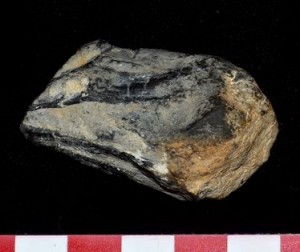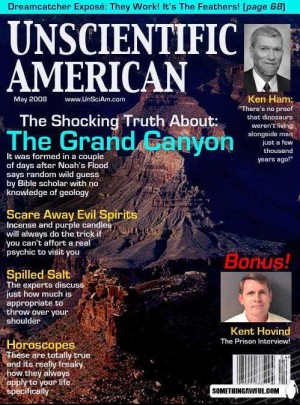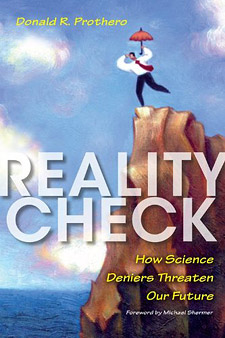Skepticblog
About Donald Prothero

Donald R. Prothero was Professor of Geology at Occidental College in Los Angeles, and Lecturer in Geobiology at the California Institute of Technology in Pasadena. He earned M.A., M.Phil., and Ph.D. degrees in geological sciences from Columbia University in 1982, and a B.A. in geology and biology (highest honors, Phi Beta Kappa) from the University of California, Riverside. He is currently the author, co-author, editor, or co-editor of 28 books and over 250 scientific papers, including five leading geology textbooks and four trade books as well as edited symposium volumes and other technical works. He is on the editorial board of Skeptic magazine, and in the past has served as an associate or technical editor for Geology, Paleobiology and Journal of Paleontology. He is a Fellow of the Geological Society of America, the Paleontological Society, and the Linnaean Society of London, and has also received fellowships from the Guggenheim Foundation and the National Science Foundation. He has served as the President and Vice President of the Pacific Section of SEPM (Society of Sedimentary Geology), and five years as the Program Chair for the Society of Vertebrate Paleontology. In 1991, he received the Schuchert Award of the Paleontological Society for the outstanding paleontologist under the age of 40. He has also been featured on several television documentaries, including episodes of Paleoworld (BBC), Prehistoric Monsters Revealed (History Channel), Entelodon and Hyaenodon (National Geographic Channel) and Walking with Prehistoric Beasts (BBC).
RSS feed for this authorfaculty.oxy.edu/prothero
Subjects
aliens alternative medicine atheism autism belief bigfoot Brian Dunning CAM Carl Sagan climate change conspiracy theories Creation creationism critical thinking cryptozoology denialism dinosaurs Dr. Kiki earthquakes economics education environment ethics evolution fossils geology Ghost Hunting ghosts global warming God homeopathy intelligent design james randi journalism media medicine michael shermer morality nasa paleontology paranormal politics pseudoscience Psychics psychology religion science science denialism scope SETI Shermer skeptical history skepticism skeptoid Skeptologists TV ufo ufos vaccines videoRecent Comments
- Daniel Loxton commented on A Fond Farewell to Skepticblog at 1:25 pm, September 18, 2014
- markx commented on A Fond Farewell to Skepticblog at 8:52 pm, September 17, 2014
- Thomas commented on False Equivalence at 11:44 am, September 15, 2014
- John Greg commented on A Fond Farewell to Skepticblog at 2:10 pm, September 13, 2014
- tmac57 commented on A Fond Farewell to Skepticblog at 10:39 am, September 13, 2014
Read posts by author:
Credential Mongering
This past few days, the internet has been buzzing with conflicting reports that cryptozoologist Roy Mackal has apparently passed away. I first heard about it on Sharon Hill’s Doubtful News site, and it is also reported on Cryptomundo.com. There is also a post from a funeral home in Illinois saying he passed away back on Sept. 13, but apparently no one in the cryptozoology community knew about it until just now. However, I can find no formal obituary for him on the web, and his Wikipedia entry still doesn’t mention it. Born August 1, 1925, he would have been 88 years old, and apparently no one has been in touch with him for a long while, but it’s really surprising that the news is just reaching us three months late. I’m sorry to hear of his passing. I never met the man, but I’ve talked to a lot of people who did, and he seems to have been open and friendly and kind—but also a complete believer in the crazy notions that the Loch Ness monster and Mokele Mbembe were real.
comments (6)Noah’s reality check

The grandiose “artist’s conception” of the Ark Encounter. Already, many of these elements have been canceled due to problems in fundraising
A few weeks ago, I blogged about the problems that creationist minister Ken Ham is having with his proposed “Ark Encounter” project, to be built near his Creation “Museum” in northern Kentucky. Fundraising for the “Ark Park” is woefully behind schedule so his organization is trying to finance it with junk bonds. In the meanwhile, his original Creation “Museum” is losing more and more money as fewer visitors bother to show up to a carny act that is five years old and has nothing new to offer. His organization may have risen rapidly to become the loudest and biggest of all the major creationist ministries in the United States, but now it looks like they’ve gone beyond their level of competence. Not only do they mangle science with their “Museum”, but it appears they mangle finance as well. (continue reading…)
comments (14)Hogwash!
This past week I’ve been getting all sorts of questions from people about the strange study just reported in the British tabloid The Daily Mail. Some scientist in Georgia claims that humans are formed by hybridizing apes and pigs. At first, I thought it was a hoax or some outrageous parody or Poe, or possibly an example of the media distorting the original results beyond all recognition, because it’s so crazy that it’s hard to imagine any legitimate scientist making that claim. But a little digging shows it’s not a hoax or parody: there is a crackpot scientist out there who had made the claim, and naturally the media loved it and published it without any fact-checking (as usual).
First, the assertion: a Georgia geneticist, Dr. Eugene McCarthy (a sad coincidence that he has the same name as the groundbreaking anti-Vietnam War presidential candidate in 1968) claims that humans have evolved by hybridization between a boar and a female chimpanzee. Anyone trained in genetics or evolution will immediately do a double-take reading this, because it so far off the edge of crazy that it cries out to be examined further. So you click on the link, and what do you find? Is there a ton of genetic data, peer-reviewed and published in a respectable journal, that would allow us to take the claim seriously? No, not even close. Not only is it a wild claim made on a personal website without any peer review (the classic sign of crackpot science), but the evidence is not genetic at all, even though the author claims to be a legitimate geneticist! Once you go to the original link, you find that it’s a list of superficial fleshy similarities between the soft tissues of pigs and humans: naked skin, thick skin, sweating, protruding cartilaginous nose, eyebrows, heavy eyelashes, short thick upper lip, earlobes, and a long list of minor similarities in the skeleton and rest of the anatomy. Anyone who is a vertebrate anatomist familiar with phylogenetics will immediately notice that these are highly correlated characters that all occur together when a a lineage becomes less hairy, or else they are symplesiomorphic features shared by most placental mammals. What the list doesn’t point out is all the huge and fundamental differences in the skeleton he doesn’t mention, especially the unique “cloven-hoofed” even-toed hands and feet of pigs with the “double-pulley” astragalus bone, which unites them with all other artiodactyls (the “even-toed” hoofed mammals), a feature seen in no primate or any other organism on earth; and the huge differences in the skull, braincase and ear region that allow any competent anatomist to immediately distinguish a pig from any primate. Once again, it’s a classic case of someone not trained in a given field (anatomy and phylogenetics) dabbling in someone else’s orchard, cherry-picking data he doesn’t understand, and ignoring everything that flatly contradicts his ideas. Surprisingly, the one thing I would expect him to list—the low-cusped bunodont dentition of pigs and primates—isn’t mentioned (again, it’s convergent evolution since pigs and many primates have an omnivorous diet, as do bears and peccaries, who also convergently evolve bunodonty). As P.Z. Myers pointed out (he calls it the “MFAP hypothesis”, “monkey fucked a pig”), it’s very similar to the long-discredited “aquatic ape” theory of Elaine Morgan—cherry-pick a handful of superficial anatomical characters associated with loss of body hair in apes and tell a just-so story, ignoring all the rest of the evidence. (continue reading…)
comments (10)The Paranormal is Normal
For our new book on cryptozoology, Daniel Loxton and I delved deeply into the psychology of those who believe in Bigfoot and Nessie and the rest. What about these people who believe in cryptids? What can we say beyond the anecdotal descriptions of the Bigfoot subculture that I discussed in my August 28 post? There are actually large-scale rigorous studies that have been done to see what the population as a whole, and what kinds of people in particular, think about paranormal topics. The most famous is the Baylor Religious Survey, a huge data set of multiple choice questions collected almost each year since 2005, which looks not only at beliefs, but also at the demographic data behind them. If you look for the questions that mention cryptids like Nessie and Bigfoot, you can get a sense of how widely these ideas are held in the sample of hundreds of people included in the survey. For example, about 17% of the people in the sample agreed or strongly agreed with the statement: “Creatures such as Bigfoot and the Loch Ness Monster will one day be discovered by science,” while about 56% disagreed or strongly disagreed (27% were undecided). About 20% said “yes” to the question: Have you ever read a book, consulted a Web site, or researched the following topics: Mysterious animals, such as Bigfoot or the Loch Ness Monster? The highest percentage of those people who agreed with cryptozoological ideas were young (18-30) single white males with only a high-school education or less, lower incomes, but who do not tend to be very religious, either.
In their book Paranormal America, Bader et al. (2011) point out that belief in the paranormal is held by about two-thirds of Americans, and the average American holds at least two paranormal ideas to be true. In other words, most Americans believe in the paranormal, making it the norm in our culture. The skeptics and non-believers are the minority, the “abnormal ones”.
comments (13)Junk science and junk bonds
In previous posts, I’ve written about creationist Ken Ham’s efforts to get an “Ark Encounter” theme park built near his Creation “Museum” in Petersburg, Kentucky. When it was first announced, they promised to make it the Seventh Wonder of the World, and even the Governor and State Legislature of Kentucky agreed to tax breaks and new roads to help them out. The Ark model will just be the centerpiece of a huge amusement park to sucker in the rubes. According to Mark Joseph Stern, writing for Slate.com:
comments (2)Like most of Ham’s projects, Ark Encounter promises to be a heady combination of hands-on fun, perverse indoctrination, and apocalyptic terror. According to Ham’s fundraising newsletters, the ark itself will contain three levels of “edu-tainment” about Noah’s menagerie—which, as noted in his magnum opus Dinosaurs of Eden, included every species of dinosaur, even T. Rex. (How did they fit? As always, Ham has an answer: “When it came to the very few dinosaur kinds that grew to a very large size, God probably sent ‘teenagers,’ NOT ‘fully grown adults’ on the Ark.”) The ark’s exhibits will likely follow the lead of the Creation Museum, intertwining spectacularly weird animatronics, comically idiotic sophism, and menacing warnings of cultural decay.
NFL follows the tobacco company playbook
In my new book Reality Check, I described research by a number of authors who investigated and exposed the 50-year-long effort by the tobacco companies to deny that they made a product that was dangerous. They did all they could to obfuscate and delay public health action by the well-known tactic of “smokescreens” to hide their real action. As the famous quote by the PR firm Hill & Knowlton (hired in the 1950s to advise Big Tobacco) said, “Doubt is our product since it is the best means of competing with the ‘body of fact’ that exists in the minds of the general public. It is also the means of establishing a controversy.” For the next fifty years, the tobacco companies pursued this strategy. They paid for research by their own scientists, and suppressed or censored the results if they showed that tobacco was dangerous, but vigorously promoted any results that seemed favorable to them. They waged an all-out campaign to harass and impugn the research by outside scientists who discovered that tobacco was dangerous. They played the classic game of “doubt” mongers everywhere: insist on absolute scientific “certainty”, so that if the results are overwhelming (say, 80-90% certain), they would argue that it’s not good enough. (This, of course, plays on the public misconception about science, which is always about statistical likelihood, and rarely deals in true “certainty”). They hired prominent scientists in totally unrelated fields like nuclear physics to be their spokesmen, and to fight their battles in the public arena, especially in the halls of Congress. These people often played the “other causes” fallacy: if a disease like lung cancer can occur because of multiple causes, the tobacco companies would focus on these minor “other causes,” and insist that nothing should be done about regulating their own industry—even though all the independent research clearly showed that smoking was by far the most important cause of lung, throat, mouth, and other cancers. They fought their opponents vigorously with lawsuits and armies of lawyers, and battled tooth and nail to never lose a lawsuit against them—because one admission that they were responsible for someone’s death due to smoking would unleash an avalanche of lawsuits against them. Above all, they waged a relentless PR campaign to make tobacco seem safe and glamorous, or minimize its dangers, even as the weight of scientific evidence and public opinion was becoming overwhelmingly against them. (continue reading…)
comments (29)Krakens and crackpots—again

The alleged “fossil kraken beak” touted by McMenamin as the beak of the giant kraken responsible for arranging ichthyosaur bones into art. The scale is in centimeters, so it is only 5 cm long, too small to belong to any giant squid. In addition, the preservation and other details of the specimen do not resemble a cephalopod beak but some other rock or concretion.
Readers of this blog might remember a post two years ago, when I reported on the notorious crackpot paleontologist Mark McMenamin, and his claim that the ichthyosaur skeletons at Berlin-Ichthyosaur State Park in southwest Nevada were artistically arranged by some sort of huge “Kraken” squid. As I detailed in my post, the claim was laughably incompetent and ridiculous. McMenamin claimed that the arrangement of the vertebrae appeared to be deliberate, an arrangement satisfying the “artistic sense” of the giant squid. Clearly he does not know enough about the decay processes of vertebrate skeletons, which frequently leave the vertebral centra either lined up, or toppled over in rows just like we see in the Nevada ichthyosaurs. I vividly remember the buzz at the Geological Society of America (GSA) meeting in 2011, where McMenamin gave his presentation and people were openly laughing at its totally ridiculous claims—or not sure whether they were unwittingly part of an episode of “Punked” and Ashton Kutcher was going to pop out any moment. We all figured it was just another crazy idea by a notorious fringe scientist, and wrote it off to carelessness on the part of the committee that programmed the abstracts (they don’t really have the option of reviewing or rejecting them unless the abstract violates the basic formatting guidelines). The only sad consequence of this whole sordid episode is that the press and internet jumped all over this half-baked story, giving it all sorts of unwarranted coverage. As usual, the media don’t know (or don’t care) that meeting abstracts are unreviewed. They should not be given a lot of press coverage until they are peer reviewed and published. But in this age of 24/7 media coverage of junk, any sensational claim will make the news without any review or background checking or fact checking whatsoever—so McMenamin got his 15 minutes of fame for spewing junk science. (continue reading…)
comments (3)Sham Science
In a previous post, I discussed the saga of the infamous “Bigfoot DNA” study by Melba Ketchum, a Texas veterinarian and staunch believer in Bigfoot. There was lots of gossip about it in the cryptozoology community for several years, then it was officially announced to the press (long before any supporting evidence was published) last fall. When it was finally “published” last spring, it was raised all sorts of red flags with the absurd claims that her Bigfoot samples were uncontaminated (yet all the evidence showed that it was), the lack of evidence that the hairs and tissues truly could be proven to come from Bigfoot, and the claim that Bigfoot was some sort of weird hybrid between modern humans and prehistoric populations. The study was highly suspect, because Ketchum self-published it in an online journal that she secretly owned, and there was no peer review. Her samples were finally analyzed by an independent genetics lab last summer, and the results were clear: her original analysis was completely incompetent, and she made all sorts of fundamental mistakes and false assumptions that no well-trained geneticist would make. After all that fanfare, her specimens only showed a mix of modern human hairs and tissues, along with those of other North American mammals, especially opossums.
Sharon Hill has pointed out that lots of pseudoscientists and followers of the paranormal try to act “sciencey”, or practice what she called “sham science”: they mimic the trappings of science (white lab coats, fancy lab equipment and glassware, exotic toys like night-vision goggles and camera traps), yet the fail to follow the basic methods of science. They are akin to the “cargo cults” in Polynesia at the end of World War II, whose islands became military bases and airstrips in service of the war effort. When the war ended and the military left, the islanders built imitation wooden “airplanes”, “control towers” and even “radio masts”, thinking that if they reproduced the shape of these objects, they would magically bring back the military planes and all their cargo full of goodies. In the case of cryptozoology, there are many instances where these pseudoscientists fail to follow the basic methods of science, but the most obvious is that if an object is not yet explained, it is not necessarily paranormal! The basic assumption in science is that the unexplained is not unexplainable, just not yet fully explained—but eventually these unexplained phenomena are explained by natural processes. We see this every time another object is claimed to be “Bigfoot hair” (rather than just hair that is not yet identified) or an image is touted as “an unexplained black shape that may be Bigfoot” (rather than “an unexplained black shape whose identity cannot be determined”). They jump to the conclusion and assume what is to be proved, rather than following the scientific method and reserving judgment until something is fully investigated. When they hear a strange sight or sound, they say “It’s Bigfoot!”, when the scientist would say “What is it? Let’s investigate all the possibilities.”
The same is true of creationists, who argue that if science hasn’t explained something yet (at least to their satisfaction), then it can’t be explained, and therefore God did it (the “God of the gaps” argument). They never seem to realize that as science explains more and more, their God becomes less and less useful, and the argument is ultimately a loser–as well as being unscientific. (continue reading…)
comments (11)Another victim of the Congressional game of “chicken”: American science
I have come to a conclusion that one useless man is a shame, two is a law firm, and three or more is a congress.
—John Adams
Suppose you were an idiot, and suppose you were a member of Congress; but I repeat myself.
—Mark Twain
Over the past three weeks, we got to see an extraordinary demonstration of Kabuki theater: politicians posturing and speechifying and saying silly and downright seditious things, all to placate their voter “base” that believes the idiocy they spew. I won’t dwell on the details, but anyone who remembers their “Schoolhouse Rock” realizes that the Affordable Care Act (ACA) is already the law of the land: passed by both Houses of Congress in 2010, signed by the President, and upheld by the Supreme Court last year, it cannot be changed unless its opponents capture majorities in both Houses of Congress and the Presidency. Since Obama campaigned on the ACA in 2012, and Romney campaigned against it, and Obama won the presidency by over 5 million votes (and the GOP lost seats in both Houses of Congress), it is clear that the “repeal” of the ACA was rejected by the voters as well. Surely most of the members of Congress, who are typically lawyers and took constitutional law, know this. Instead, we get this farce about “defunding Obamacare.” Never mind that the GOP doesn’t have the votes to do this; never mind the fact that most of the ACA is already in place, or going into effect the day the stalemate started with a stampede of people signing up to join it; never mind that much of the spending is mandatory and cannot be changed by Congress. As Igor Volsky pointed out:
comments (15)“Inter-party squabbling aside, defunding Obamacare in the continuing resolution would only target the parts of the law that are subject to annual appropriations. The pillars of reform — Medicaid expansion, the subsidies used to buy insurance — are exempt from this process and are funded through so-called “mandatory” spending and have permanent funding authority. The Department of Health and Human Services, the agency tasked with implementing reform, also “has the ability to fund related provisions without seeking additional appropriations from Congress.”
Hosted by Skeptic magazine. For website-related matters, contact the webmaster.





Come join the Skeptic Society for our trip to Area 51 and other alien landscapes, Martin Luther King weekend (January 18-20), 2014. We will spend 3 days exploring the “Extraterrestrial Highway” (with lunch at the Little A’Le’inn), collecting trilobites, and visiting the National Atomic Testing Museum and their UFO exhibit, as well as the alien landscape of Valley of Fire State Park and Calico Ghost Town. Both nights will be spent at the MGM Grand Hotel in Las Vegas. For further details, see this link. Hurry! We’re down to our last few seats!
We are driving west in a black GMC Yukon Denali SUV across the “Extraterrestrial Highway” (Nevada State Highway 375), about three hours north from Las Vegas. The road itself is unremarkable—miles and miles of a ribbon of asphalt cutting across barren desert of mesquite and Joshua tree yuccas, with no signs of life anywhere. Occasionally the road rises up from the low flats to cross a small mountain range, with jagged rocks exposed on all sides, completely devoid of vegetation. During the summer, the temperatures here stay above 100°F for weeks on end, and almost no one comes through here. In the winter, the daytime temperatures are more comfortable, but at night it gets bitterly cold, especially if the desert winds are howling through the area. It’s also over 4400 feet in elevation here, so some winters are cold enough that snow will accumulate on the high desert surface, and may persist on the peaks well into the spring.
After you pass through the tiny towns of Alamo and Ash Springs (last gas station for 150 miles or more) on U.S. Highway 93, and turn west on to Highway 375, you drive about 15 miles until you reach Hancock Summit, a mountain pass over barren rock that is the highest place in the region. You can get out of your car and look to the southwest, but all you will see is the Groom Range to your west. The military base is down in the valley beyond, and there is no other spot in any direction where you could see the base from the paved road. You can make the strenuous hike to Tikaboo Peak to the south, and see parts of the base on the other side of the range without incurring the wrath of base security, but this isn’t much more informative. (continue reading…)
comments (1)